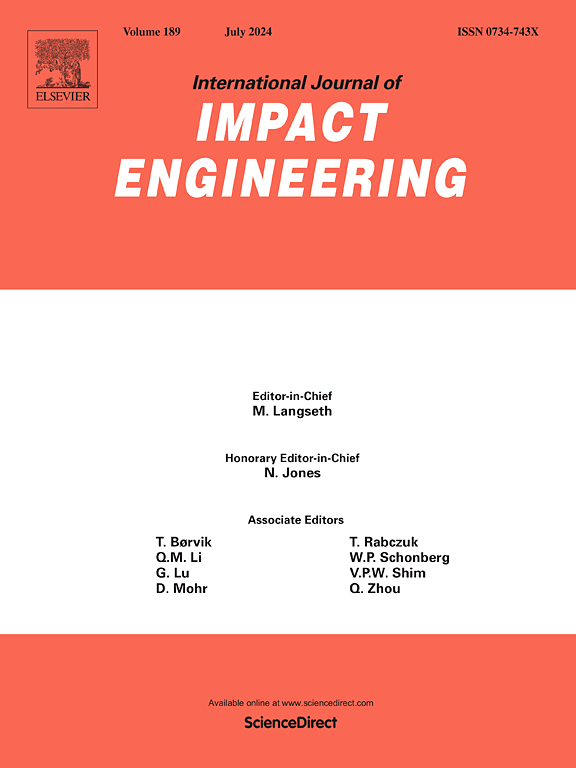Ballistic properties of bioinspired nacre-like ceramic/polyurea staggered composite structures
IF 5.1
2区 工程技术
Q1 ENGINEERING, MECHANICAL
International Journal of Impact Engineering
Pub Date : 2024-10-02
DOI:10.1016/j.ijimpeng.2024.105137
引用次数: 0
Abstract
We proposed a bioinspired ceramic/polyurea composite plate that draws on a “brick-mortar” arrangement of nacre layer, with a periodic three-dimensional structure and interlayers polyurea elastomers. We fired a 12.7 mm armor-piercing incendiary bullet using a ballistic gun to conduct depth-of-penetration (DOP) experiments. We analyzed the damage, fracture morphology, and residual DOP of ceramic/polyurea-staggered composite structures (CPSCS), with a theoretical prediction model for the residual DOP. Using the adaptive FEM-SPH algorithm, we compared the damage morphology of CPSCSs. We analyzed projectile penetration process and summarized four toughening modes using stress wave propagation. Based on simulation fitting and theoretical calculations, we obtained the residual DOP curves at different projectile velocities and analyzed the toughening effect of the CPSCSs through the energy dissipation of each structural component. When the areal density was the same, the residual DOP of the CPSCSs decreased by 33.9 %, and the critical velocity theoretically increased by 32.72 %. The error between the model calculations and experimental results was 11 %. The CPSCSs enabled the ceramic to increase the energy absorption efficiency by 179.70 %. With the same structural form, changing the thickness of only one component did not have the same effect on the structural energy-absorption efficiency as changing the entire form.
生物启发的珍珠质陶瓷/聚脲交错复合结构的弹道特性
我们提出了一种生物启发陶瓷/聚脲复合板,它借鉴了珍珠层的 "砖-砂 "排列,具有周期性三维结构和聚脲弹性体夹层。我们使用弹道枪发射了一颗 12.7 毫米穿甲燃烧弹,进行了穿透深度(DOP)实验。我们分析了陶瓷/聚脲交错复合材料结构(CPSCS)的损伤、断裂形态和残余穿透深度,并建立了残余穿透深度的理论预测模型。利用自适应 FEM-SPH 算法,我们比较了 CPSCS 的损伤形态。我们分析了弹丸穿透过程,并利用应力波传播总结了四种增韧模式。基于模拟拟合和理论计算,我们得到了不同射弹速度下的残余 DOP 曲线,并通过各结构组件的能量耗散分析了 CPSCS 的增韧效果。当等密度相同时,CPSCS 的残余 DOP 下降了 33.9%,临界速度理论上增加了 32.72%。模型计算与实验结果之间的误差为 11%。CPSCS 使陶瓷的能量吸收效率提高了 179.70%。在结构形式相同的情况下,仅改变一个部件的厚度对结构能量吸收效率的影响不如改变整个结构形式。
本文章由计算机程序翻译,如有差异,请以英文原文为准。
求助全文
约1分钟内获得全文
求助全文
来源期刊

International Journal of Impact Engineering
工程技术-工程:机械
CiteScore
8.70
自引率
13.70%
发文量
241
审稿时长
52 days
期刊介绍:
The International Journal of Impact Engineering, established in 1983 publishes original research findings related to the response of structures, components and materials subjected to impact, blast and high-rate loading. Areas relevant to the journal encompass the following general topics and those associated with them:
-Behaviour and failure of structures and materials under impact and blast loading
-Systems for protection and absorption of impact and blast loading
-Terminal ballistics
-Dynamic behaviour and failure of materials including plasticity and fracture
-Stress waves
-Structural crashworthiness
-High-rate mechanical and forming processes
-Impact, blast and high-rate loading/measurement techniques and their applications
 求助内容:
求助内容: 应助结果提醒方式:
应助结果提醒方式:


